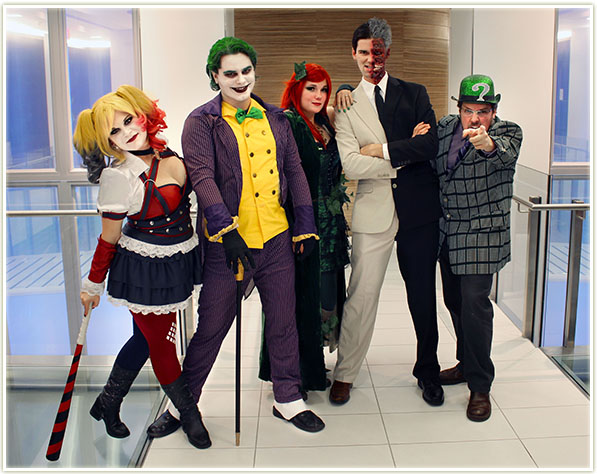
Continuing the Halloween theme, today’s post is on the makeup I did on my husband David to transform him into The Joker!

A little bit about his costume: he picked up the outfit on Ebay from a relatively well known brand (Rubies) in a medium. It came with a fairly horrible mask that we didn’t end up using and the full suit. The suit was constructed of a rather thin material and the yellow-gold vest it came with was really bad. David went to a second hand store and bought a women’s yellow jacket and transformed it into a vest-type thing that he then attached the jacket to. I was impressed with how much he changed that yellow jacket to look just like the Joker’s vest! The cane was bought individually from the same company, but the stick of it was spray painted black by him (the whole thing was originally gold). He also created the spats on the shoes out of white vinyl.
The Joker


Halloween 2015: The Joker
Honestly, the makeup wasn’t all that different from my own as Harley Quinn. This was my first time doing full face makeup on a male and I didn’t really know what to expect. He usually has facial hair, but shaved it all off for this (which was hilarious because I’d never seen him without facial hair and he hadn’t either since his teens!).

I prepped his skin with Make Up For Ever‘s Step 1 Smoother Primer because… man pores. Then I mixed a bit of Revlon‘s Colorstay foundation in Buff with a lot of Inglot‘s white concealer and sponged it onto his face using a Real Techniques Miracle Complexion Sponge. I actually had to do three layers, which kind of surprised me. It felt like his skin was very, very resistant to makeup… like it just kept absorbing it! So bizarre. I set the layers of makeup with Hourglass‘ Ambient Lighting Powder in Ethereal Light and did a little bit of contouring with MAC‘s Print and Handwritten eyeshadows. In hindsight, Print wasn’t the right colour to use, and David asked for more brown to be added in.

The eyes were intentionally sloppy and messy – I layered a bunch of Laura Mercier purple shadows (Plum Smoke and Violet Ink) to make them look sunken. I tried to line his eyes with Maybelline‘s black pencil gel liner, but he was so twitchy that I had to give up and just smudged the terrible lines out with a pencil brush. I filled in his brows with Sleek‘s Dragonfly eyeshadow – that went really easily. His eyebrows are bushy enough that they just held the colour like nobody’s business!
The lips were my main concern but they came out okay. We hadn’t done any kind of trial run of the makeup so it was basically do or die. I lined them with Kat Von D‘s Tattoo Liner in Trooper, curling out the edges to give him an elongated smile. I filled them in a bit with the liner and then applied NARS Matte lip pencil in Cruella on his lips and tried to make them blend into the black liner. In the end, I think the red lipstick either wore off his lips too quickly or I didn’t apply enough because I don’t think you can really see the red as much in the photos.
While I was busy getting ready, Alison styled (seriously, awesome job woman, you killed that hair style!) and sprayed his hair with Graftobian‘s green hair colour.


That’s it for this round! Click through to see some of the other costumes: | Harley Quinn | Poison Ivy | Two Face |
Ok that Joker smile is creeping me out!
Julie recently posted…SPOILER ALERT: Inside the Benefit Cosmetics Party Poppers 12 Days of Gorgeous 2015 advent calendar
SCORE! 😀
Shaving his face for halloween – that’s a commitment! is he growing it back out now or is he going to stay smooth? You did an awesome job on his makeup and he did a fantastic job on his costume!
Rebekah recently posted…weekly highlights
He’s growing it back and right now it feels like razorblades on my face whenever I give him a kiss! I can’t wait till it grows back in fully!